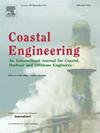盐沼草用于减少溢流动量:实验结果和 XBeach 校准
IF 4.5
2区 工程技术
Q1 ENGINEERING, CIVIL
引用次数: 0
摘要
沿海建筑物顶部的盐沼草有可能减少溢出的水流动量,从而减轻波浪溢出的危险。然而,由于缺乏大规模活植被实验的定量数据和经过验证的设计工具,实施受到阻碍。为了解决这一问题,在全几何尺度下,对暴露于溢流后的活盐沼草进行了实验。该流量由实验室溃坝水槽产生,复制了非冲激波破碎后斜坡海岸结构顶部上覆流的水力参数。植被的偏转分为出现、过渡和淹没状态。对于每个冠层长度,使用最大动量通量和入射流的总动量来预测这些状态。XBeach-Veg数值模型准确地模拟了出现的状态,平均散射指数SCI=0.19。在淹没状态下,下游锋面速度被低估(偏差= -0.82 m/s, SCI=1.04)。关闭植被模块并提高不透水河床高度以复制水下植被几何形状,准确模拟了下游锋面速度(偏差= 0.01 m/s, SCI=0.15)。出现的盐沼草可以有效地减少下游的水流动量,并可以减轻对行人的滋扰。对于高事件水流动量,盐沼草偏转直到淹没,不会减少下游的水流动量,因此不能有效地减轻危害。本文章由计算机程序翻译,如有差异,请以英文原文为准。
Salt marsh grass for reducing overtopped flow momentum: Experimental results and XBeach calibration
Salt marsh grass on the crest of coastal structures has the potential to reduce overtopped flow momentum and therefore, mitigate wave overtopping hazards. However, implementation is hampered by the lack of quantitative data from large-scale live vegetation experiments and validated design tools. To address this, experiments were conducted with live salt marsh grass exposed to post-overtopping flow at full geometric scale. The flow, created by a laboratory dam-break flume, replicates hydraulic parameters of overtopped flows on the crest of sloped coastal structures following non-impulsive wave breaking. The deflection of the vegetation was categorised into emerged, transition and submerged regimes. For each canopy length, these regimes were predicted using maximum momentum flux and the total momentum of the incident flow. The numerical model XBeach-Veg accurately simulated the emerged regime, with an average scatter index . For the submerged regime, the downstream front speed was under-predicted (bias = -0.82 m/s and ). Disabling the vegetation module and raising the impermeable bed level to replicate the submerged vegetation geometry accurately simulated the downstream front speed (bias = 0.01 m/s and ). Emerged salt marsh grass is effective at reducing downstream flow momentum and can mitigate nuisance overtopping hazards to pedestrians. For high incident flow momentum, the salt marsh grass deflects until submerged, does not reduce downstream flow momentum and is therefore not effective at mitigating hazards.
求助全文
通过发布文献求助,成功后即可免费获取论文全文。
去求助
来源期刊

Coastal Engineering
工程技术-工程:大洋
CiteScore
9.20
自引率
13.60%
发文量
0
审稿时长
3.5 months
期刊介绍:
Coastal Engineering is an international medium for coastal engineers and scientists. Combining practical applications with modern technological and scientific approaches, such as mathematical and numerical modelling, laboratory and field observations and experiments, it publishes fundamental studies as well as case studies on the following aspects of coastal, harbour and offshore engineering: waves, currents and sediment transport; coastal, estuarine and offshore morphology; technical and functional design of coastal and harbour structures; morphological and environmental impact of coastal, harbour and offshore structures.
 求助内容:
求助内容: 应助结果提醒方式:
应助结果提醒方式:


